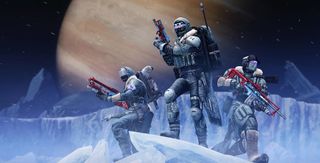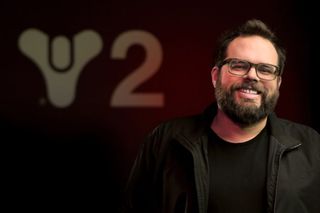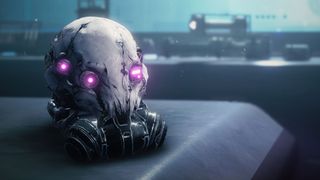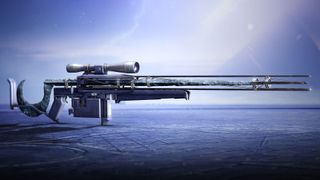Luke Smith on Beyond Light, unvaulting destinations and why Destiny 2 can't get rid of blue gear
Bungie's creative director also discussed why Destiny is like basketball, shortening login times, and keeping loot too long.

Today, Destiny 2's Beyond Light expansion opens a new phase in the unexpectedly long lifetime of the premier loot ’n’ shoot MMO. As the storyline for its sixth year brings a new destination, Jupiter’s ice moon, Europa, and the much-heralded but mysterious Darkness further encroach on the Solar System, the game itself will see the razing—or 'vaulting'—of a swathe of older content, along with the reintroduction of the classic Cosmodrome and, at a later date, the return of the Vault of Glass, the game's iconic first raid.
Last week we spoke to creative director Luke Smith on the eve of an important moment in Destiny's history, as the now-venerable shared-world shooter sets itself up for another three years of expansions.
He smooths expectations for when the Darkness will actually start making themselves seen (sounds like it might be a while) and what un-vaulting older content really means (don’t expect Io, Mars and all to come back any time soon), talks of plans to speed up login and the time it takes to get into shooting, and why it’s so damn hard to make blues worthwhile.
This interview has been edited and arranged for length and clarity.
PCG: When we last talked, you told me that it would be boring if the Light was always good and the Darkness was always completely bad. But if the Darkness isn't all bad, how do you create the sense of menace that a game like Destiny needs? How is it us against the universe if we're actually chill with the pyramids?

Luke Smith: I don't know that it's chill! The situation in Beyond Light is a time of need when players are going to need to use a power [the Darkness-imbued Stasis] that maybe they otherwise wouldn’t. Our trailers do a great job of making our content bright and hopeful and inspiring, and course we're going to make it as fun as humanly possible, but players are using something that they have to. You'll start to take some steps into some broader stuff about the universe over the next few years.
PCG: I was excited to see the pyramid ships arrive and I was expecting things to start spilling out of them and for decimation to ensue, but instead we got the Contact public event. Are you confident of 'landing' the arrival of Darkness in Beyond Light? Is it going to feel like a blowout? Because otherwise, aren't we just fighting the same enemies wearing different outfits?
The biggest gaming news, reviews and hardware deals
Keep up to date with the most important stories and the best deals, as picked by the PC Gamer team.
Luke Smith: I'm confident in where we’re going. One of the challenges is always going to be the expectations of people riffing on old images from a GDC talk seven years ago or whatever, where it’s like, 'Look at the pyramids and that’s the new race, it says on the slide, race 5!' Expectations from a fantasyland presentation before the game came out are always going to be difficult to compete with, and it's a slow roll with the pyramids, Darkness and the villains of Destiny, but we're rolling toward it.
[Luke is referring to a GDC 2013 talk by Destiny art director and Destiny 2 creative director Chris Barrett and writer Joseph Staten, at which they showed off very early concept art of Destiny's races which included a fifth one characterised by flying pyramid shapes and bodies apparently made from smoke. For now, the community has named these creatures The Veil.]

PCG: Next week you're vaulting destinations for the first time. What will un-vaulting a destination be like? Is it going to need to be substantially altered? Is there a risk that they'll feel over-familiar, like, 'Well, here’s Mars again'?
Luke Smith: We've thought about this a fair bit. For the destinations that are going away there are no immediate plans that they’re going to come back. Each expansion is going to include a brand-new destination, so The Witch Queen [Destiny 2’s 2021 fall expansion] is not going to un-vault one. But destinations are part of the world and the ongoing story of Destiny, so I don't think bringing them back unchanged would be the right thing. For a destination to be un-vaulted, it has to be updated to the latest context for the universe, so even with Cosmodrome, we updated a bunch of it to the latest context and we’re re-packaging and remastering the Destiny 1 Strike formerly known as the Omnigul Strike [or The Will of Crota] and modernising it a little bit while preserving its feel.
I have a big list of ongoing concerns that we may or may not address in Destiny 2, and the gear on the colour spectrum is certainly one of them.
—Luke Smith
But even then, I put Strikes in a different category to the destinations. The destinations are part of the ongoing narrative of Destiny and Strikes are more of a gamey-game element, if you will. Bringing back a really popular Destiny 1 Strike is about putting an awesome, fun replayable thing back in the game. Bringing back a destination is about looking at its context in the Destiny 2 storylines.
PCG: When we talked before you said you were quite worried that blue gear had no real point in the game beyond using it to level up for a couple of days when an expansion drops and then it sits around in the loot pool waiting to be dismantled. Have you had any further thoughts about the way loot works?
Luke Smith: I always have thoughts about those things. I have a big list of ongoing concerns with Destiny that we may or may not address in Destiny 2, and the gear on the colour spectrum is certainly one of them. But we're in year six of Destiny, so when I think about problems with blue gear, they’re really hard because changing them in some meaningful way is going to be very difficult or upsetting, and there's a chance that we just won't get it right. So, you're used to only using Legendaries. Are you OK with the idea of not using them? We’re talking about serving you vegetables and our players are used to eating dessert. Vegetables are really important for health but they're not always super-fun to eat, so it's finding a line there. This is one of our challenges with Destiny, trying to find the line between what's good sustainable design, and the stuff that our players are going to love.
No other MMO on the planet lets you have shit for as long as we let you keep and use it...That’s a trap of our own making.
—Luke Smith
PCG: What else would you desperately love to change? Give me the biggest example that keeps you awake at night.
Luke Smith: Man, I've got to make sure to talk to the team before the article comes out! Here's one that I don't think will be super-controversial, but I think Destiny 2 requires a lot of activation energy to play. From the time you log in to the time you're engaging with content that you want to play is pretty long. Whether it's sign-in, loading into the Tower, going around and getting all your bounties, triaging the things you want to do, logging into Destiny Item Manager to give your character the same three guns you use on all your characters. That's what people do! It takes a lot of energy to get in and play, and long term, that's something I’m pretty concerned about. There's an opportunity there to enhance and make it better, and there's nothing controversial here for players: it’s just, 'Yes, god, I wish I could get into action faster.'

PCG: Destiny is essentially the first- and last-standing of the shared-world looter-shooter genre. We've seen supposed challengers like Anthem fall by the wayside and to a lesser degree, The Division is on the back burner. Destiny has had its rocky patches, for sure, but what did you get right that the others haven't been able to replicate?
Luke Smith: Without making it some headline where I say something about those other games, both of which I've played extensively—I have a tonne of great stuff to say about The Division—every time I go back to Destiny, it's the feel and the core art direction. It's the embodiment of a world I want to be a part of, and running around it feels incredible. A friend of mine, Mark MacDonald, who’s the producer on Tetris Effect, described Destiny really well on a podcast he has [the excellent 8-4 Play ] as it's like shooting free throws. They're rewarding: the kinetics of throwing them, getting good at shooting them. There's this mastery to it, and there’s also a gamefeel component.
For me there's nothing else that combines those things, and then when I add the delicious alchemy of playing with others in my friend group or even just some of the public stuff. I'm a big advocate internally in the team for things like Contact and Escalation Protocol, which are in the public space. I like the optionality of engagement. I can run through the bubble and help or not, based on my mood.
PCG: How about some quick-fire questions. With the advent of the next-gen consoles, is there any movement on cross-play with PC?
Luke Smith: Yes, cross-play is in development and we intend to ship it next year.
PCG: What's the timeline for transmog?
Luke Smith: We're working on it and shipping it next year.
PCG: What's Chris Barrett doing these days?

Luke Smith: Chris Barrett is an awesome member of the Bungie team and working on exciting stuff, and it's redacted. [He’s almost certainly leading Bungie’s next game which, according to job listings, may be "lighthearted" and "whimsical".]
PCG: I've played 5000 hours in your game. What would you like to ask me?
Luke Smith: What are the top three issues you see with it right now?
PCG: Oh Jesus. We only have a couple of minutes to go through this!
Luke Smith: Pick number one, then!
PCG: I'll play the game for another 5000 hours provided the loot's right. There's something about the cadence of creation of new loot that I think could be better. Maybe sunsetting will change things, but right now it feels problematic to me. We talked about this before, about how to make a better handgun when Ace of Spades and the curated Nation of Beasts exist, and I see all those design space problems.
But at the same time, the reasons I log into Destiny are two-fold. One is exactly what you said about the hoop-shooting. I love the art design and it feels like I’m playing the book Spacewreck: Ghostships and Derelicts. But the other thing that pulls me in is the slot machine. I'm always wanting another gun. I like making builds and trying them out, and I like synergies. But while there have been points when it's been close, I feel like the loot has never quite been right. Maybe it can't with such a big cohort of players. Are you surprised by that answer?
Luke Smith: No, I think you're pointing at this higher order problem of permanence versus transience. No other MMO on the planet lets you have shit for as long as we let you keep and use it. Actually the Final Fantasy games do, but in a different way. No action game where you're meant to get new stuff lets you keep it for as long. That’s a trap of our own making.
There's a great someday-talk about the five design decisions that we made in Destiny that no other game should make, and I'm excited to help or give that talk, because they've become things players love, which is awesome, but which make building a game and shipping new and exciting things an ever-increasing challenge.
With over two decades covering videogames, Tim has been there from the beginning. In his case, that meant playing Elite in 'co-op' on a BBC Micro (one player uses the movement keys, the other shoots) until his parents finally caved and bought an Amstrad CPC 6128. These days, when not steering the good ship PC Gamer, Tim spends his time complaining that all Priest mains in Hearthstone are degenerates and raiding in Destiny 2. He's almost certainly doing one of these right now.
Most Popular

